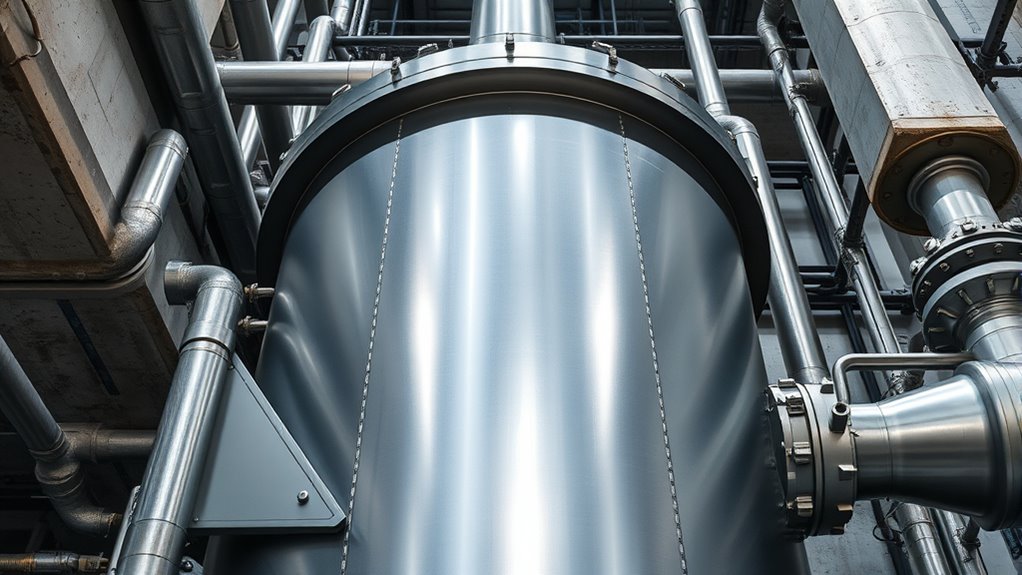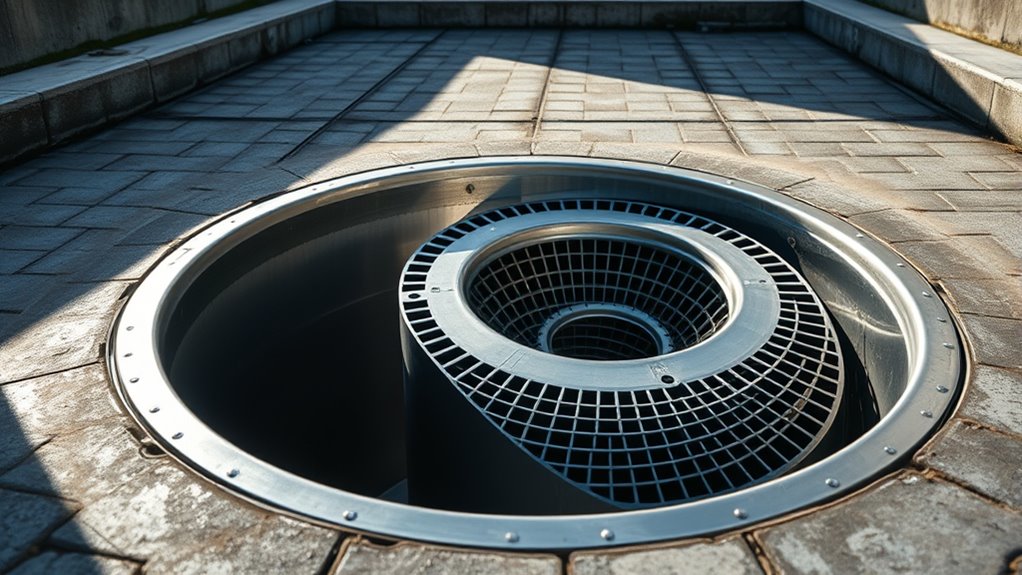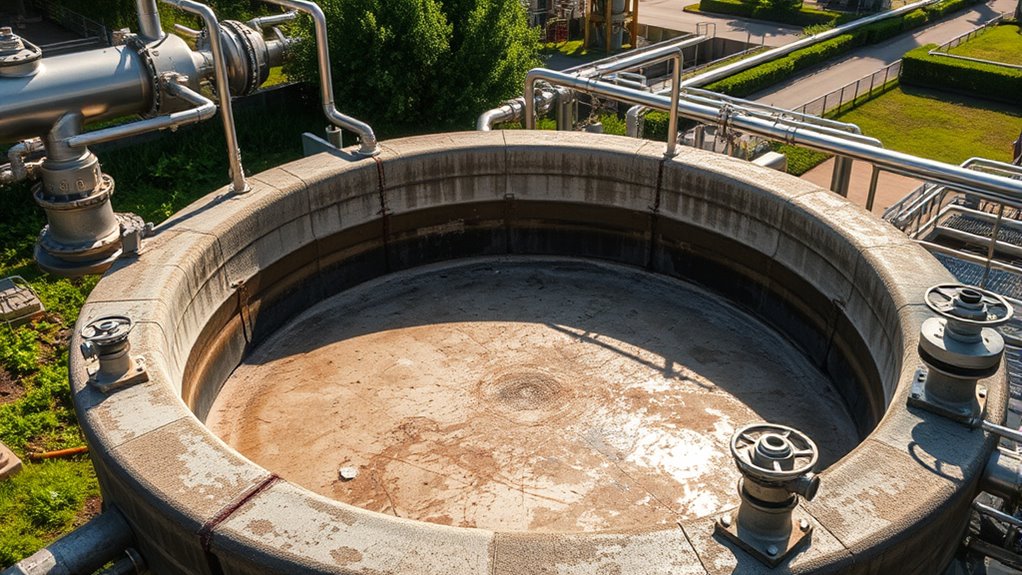A catch basin is a key part of stormwater systems that collects runoff from streets and parking lots, trapping debris and sediments while directing clean water into pipes or treatment systems. Surge tanks help manage sudden pressure changes, preventing pipe damage and leaks. Troughs guide water flow, reducing overflow and erosion during heavy rain. Materials like concrete and plastic guarantee durability, and regular maintenance keeps everything functioning smoothly. Explore further to understand how these structures work together to protect your environment.
Key Takeaways
- Catch basins collect runoff, trap debris, and filter water before directing it into underground pipes or treatment systems.
- Surge tanks absorb pressure fluctuations in water systems, preventing pipe damage and ensuring steady flow.
- Troughs serve as channels controlling water flow, preventing overflow and erosion during heavy rainfall.
- Common stormwater structure materials include concrete, plastic, and fiberglass, designed for durability and efficient flow.
- Regular maintenance of catch basins, surge tanks, and troughs involves debris removal, inspections, and ensuring safety features are secure.
What Is a Catch Basin and How Does It Function?

A catch basin is a critical component of stormwater management systems that helps prevent flooding and water pollution. It’s typically installed at low points along streets and parking lots to collect runoff. When rain falls or snow melts, water flows into the catch basin through grates that trap debris like leaves, trash, and dirt. Inside, the basin contains a sump or sump chamber where sediments settle, preventing them from clogging the drainage pipes. This design ensures that water is filtered and directed safely into underground pipes or treatment systems. As water enters, it slows down, reducing the risk of erosion or flooding downstream. Proper maintenance of catch basins, including removing debris and sediment, keeps the system functioning effectively and protects the environment from pollutants.
The Role of Surge Tanks in Water Management Systems

Surge tanks play a vital role in maintaining stability within water management systems by absorbing sudden pressure changes and flow variations. When water flow suddenly increases or decreases, these tanks act as buffers, preventing pressure spikes that could damage pipes and equipment. They help smooth out fluctuations caused by pump startups or shutdowns, ensuring consistent water delivery. Surge tanks also improve system efficiency by reducing stress on the pipeline network and minimizing the risk of pipe bursts or leaks. Their presence allows for safer operation during peak demand or emergency situations. By controlling pressure surges effectively, surge tanks protect infrastructure and extend the lifespan of your entire water management system. Additionally, incorporating pressure regulation strategies enhances the overall safety and reliability of water flow. They are essential components for ensuring reliable, safe, and efficient water flow.
Understanding Troughs and Their Applications

Have you ever wondered how water systems manage sudden changes in flow or pressure? Troughs are essential components that help control these fluctuations. They act as channels that direct water smoothly, preventing overflow and reducing pressure spikes. You’ll find troughs in stormwater management, irrigation, and industrial settings. Their primary role is to handle excess water during heavy rainfall or peak usage, diverting it safely away from critical infrastructure. Troughs can be simple open channels or covered systems, depending on their application. They also help prevent erosion and sediment buildup by guiding water along specific paths. In essence, troughs provide a reliable way to manage water flow efficiently, ensuring systems remain stable and functional during intense or sudden water surges. Additionally, understanding how bicycle tires are stored and maintained can help prevent damage and extend their lifespan, ensuring safety and performance.
Materials and Design Features of Stormwater Structures

Understanding how troughs control water flow leads you to contemplate the materials and design features of stormwater structures. These elements determine durability, efficiency, and ease of maintenance. Common materials include concrete, which offers strength and longevity, and plastic or fiberglass for lighter, corrosion-resistant options. Metal components, like stainless steel, are used where durability is critical. Design features focus on optimizing flow capacity, preventing clogging, and ensuring structural stability. You’ll find sloped surfaces, baffling, and screens incorporated to manage debris and control water velocity. Proper joint seals and reinforced walls enhance resilience against weather and heavy loads. Incorporating stormwater system components that are tailored to specific environmental conditions can further improve performance and lifespan. Selecting the right materials and design features ensures your stormwater system functions effectively, reduces maintenance needs, and withstands environmental stresses over time.
Maintenance and Safety Considerations for Catch Basins, Surge Tanks, and Troughs

Maintaining catch basins, surge tanks, and troughs is essential to guarantee their effective operation and safety. Regular inspections help identify debris buildup, sediment accumulation, or damage that could block flow or cause backups. You should remove trash, leaves, and sludge periodically to prevent clogs. Ensure covers and grates are secure to avoid accidents and unauthorized access. Safety measures include wearing protective gear during maintenance and shutting down systems when necessary. Keep detailed records of inspections and repairs to track issues over time. Proper signage around these structures can prevent accidents for pedestrians and workers. Additionally, understanding signs of spoilage in stored or used liquids can help prevent potential hazards associated with contaminated or degraded materials. Ultimately, partner with qualified professionals for complex repairs or evaluations, ensuring compliance with safety standards and extending the lifespan of your stormwater infrastructure.
Frequently Asked Questions
How Do Catch Basins Prevent Flooding in Urban Areas?
You can avert flooding in urban areas by installing catch basins that collect and filter stormwater runoff. When heavy rain occurs, these basins quickly gather water from streets and surfaces, directing it into underground drainage systems. This prevents water from pooling on roads and sidewalks, reduces the risk of flooding, and protects property. Proper maintenance ensures they work efficiently, keeping urban areas safe and dry during storms.
What Environmental Regulations Govern Stormwater Infrastructure Installations?
You need to follow environmental regulations like the Clean Water Act and local stormwater management standards. These laws require proper design, installation, and maintenance of stormwater infrastructure to minimize pollution and prevent runoff issues. You should also obtain necessary permits, conduct environmental impact assessments, and adhere to best practices for erosion control and water quality protection. Staying compliant guarantees your infrastructure supports environmental health and community safety effectively.
Can Surge Tanks Be Integrated Into Existing Water Systems?
Yes, surge tanks can be integrated into existing water systems like fitting puzzle pieces together. You’ll need to assess your current infrastructure’s flow and capacity, then work with engineers to design a seamless connection. Think of it as adding a new gear to a well-oiled machine, ensuring smooth operation during peak flows. Proper integration reduces pressure surges and maintains system stability, keeping your water management efficient and resilient.
What Are the Signs of Failure in Stormwater Troughs?
You’ll notice signs of failure in stormwater troughs if you see frequent clogging, cracks, or leaks. Water may overflow or drain slowly, indicating blockages or structural damage. Unusual debris build-up or corrosion also signals issues. If the troughs emit foul odors or there’s standing water around them, these are warning signs. Regular inspections and maintenance help catch problems early, preventing costly repairs and ensuring effective stormwater management.
How Does Climate Change Impact Catch Basin Design Requirements?
You might find that climate change keeps you on your toes, forcing you to rethink catch basin design requirements. As storms become more intense and unpredictable, you need to make certain your systems can handle increased water volumes and faster runoff. This means upgrading materials, increasing capacity, and incorporating adaptive features. Don’t put all your eggs in one basket, so invest in resilient designs that can withstand the shifting climate patterns.
Conclusion
Did you know that properly maintained stormwater structures like catch basins, surge tanks, and troughs can reduce urban flooding by up to 80%? By understanding their functions and upkeep, you play an essential role in protecting your community. Regular inspections and maintenance ensure these systems work efficiently, preventing costly damage and environmental harm. Take action today—invest in the safety and resilience of your water management infrastructure for a safer, flood-free tomorrow.









